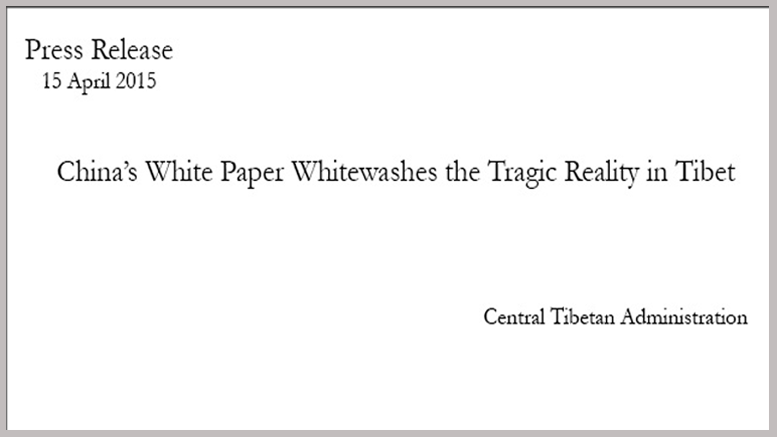Press Release:
15 April 2015
China’s State Council Information Office (China’s Cabinet) released another frenzied white paper on Tibet that clearly indicates the Chinese government’s nervousness over its grip on occupied Tibet. A Tibetan nun was the latest to self-immolate. The actions of the 137 Tibetans who have self-immolated so far clearly reflect the deepening anguish and resentment of the Tibetan people at the conditions in their homeland.
Since the early 1990s, China has issued 13 white papers on Tibet. This means Beijing has issued a white paper on Tibet for almost each of the two years within this intervening period. White papers by nature are authoritative guides on complex issues that need to be resolved or commercially as sales and marketing documents. For the Chinese government to issue 13 white papers on Tibet means that it is having great difficulty in convincing potential customers to buy its arguments on Tibet. These white papers are a dozen too many, too unconvincing and too late to arrest the worsening conditions in Tibet.
In recent times, the US State Department, the Congressional Executive Commission on China, Human Rights Watch, Amnesty International, Reporters without Border and other NGOs have pointed out the political repression, economic marginalization, social exclusion and cultural assimilation of the Tibetan people and environmental destruction on the Roof of the World. Even Chinese scientists talk about the worsening environmental degradation on the plateau of Tibet also called Third Pole.
Unlike China’s 12 other white papers on Tibet, the latest white paper seems to be a belated reaction on the part of Beijing to the renewed, ongoing campaign on the Middle Way Policy launched last year by the Central Tibetan Administration to create greater awareness of this policy within the international community. The Chinese government’s attempt to portray the Middle Way Policy as an attempt by Tibetans to strike out for independence is deliberately misleading, a huge indication of the government’s total failure to come up with better ideas. On the contrary, the Middle Way Policy seeks genuine autonomy within the framework of the constitution of the People’s Republic of China which is a win-win proposition for all parties and one lauded throughout the world including various governments. Several points raised in the Middle Way Policy are found here and here.
Unlike other white papers, this particular white paper tries to belittle His Holiness the Dalai Lama by questioning his sincerity in dealing with China. His Holiness the Dalai Lama, admired around the world and revered by the Tibetan people, does not need any certificate on his motivation from the Chinese government. His Holiness the Dalai Lama remains the unquestioned leader of the Tibetan people and also admired by Chinese people around the world.
Media organizations have often stated that international media’s access to Tibet is worse than that of North Korea, of which China is a staunch ally. Instead of issuing white papers on Tibet, China should open up Tibet to both international rights groups and media. Let them do the objective report on issue of Tibet and let the world be the judge.

